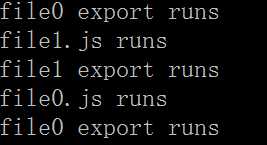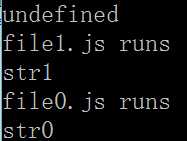标签:
在ES6前, 前端就使用RequireJS或者seaJS实现模块化, requireJS是基于AMD规范的模块化库, 而像seaJS是基于CMD规范的模块化库, 两者都是为了为了推广前端模块化的工具, 更多有关AMD和CMD的区别, 后面参考给了几个链接;
现在ES6自带了模块化, 也是JS第一次支持module, 在很久以后 ,我们可以直接作用import和export在浏览器中导入和导出各个模块了, 一个js文件代表一个js模块;
现代浏览器对模块(module)支持程度不同, 目前都是使用babelJS, 或者Traceur把ES6代码转化为兼容ES5版本的js代码;
ES6的模块化的基本规则或特点, 欢迎补充:
1:每一个模块只加载一次, 每一个JS只执行一次, 如果下次再去加载同目录下同文件,直接从内存中读取。 一个模块就是一个单例,或者说就是一个对象;
2:每一个模块内声明的变量都是局部变量, 不会污染全局作用域;
3:模块内部的变量或者函数可以通过export导出;
4:一个模块可以导入别的模块
//lib.js //导出常量 export const sqrt = Math.sqrt; //导出函数 export function square(x) { return x * x; } //导出函数 export function diag(x, y) { return sqrt(square(x) + square(y)); } //main.js import { square, diag } from ‘./lib‘; console.log(square(11)); // 121 console.log(diag(4, 3)); // 5

第一种导出的方式:
在lib.js文件中, 使用 export{接口} 导出接口, 大括号中的接口名字为上面定义的变量, import和export是对应的;
//lib.js 文件 let bar = "stringBar"; let foo = "stringFoo"; let fn0 = function() { console.log("fn0"); }; let fn1 = function() { console.log("fn1"); }; export{ bar , foo, fn0, fn1} //main.js文件 import {bar,foo, fn0, fn1} from "./lib"; console.log(bar+"_"+foo); fn0(); fn1();

第二种导出的方式:
在export接口的时候, 我们可以使用 XX as YY, 把导出的接口名字改了, 比如: closureFn as sayingFn, 把这些接口名字改成不看文档就知道干什么的:
//lib.js文件 let fn0 = function() { console.log("fn0"); }; let obj0 = {} export { fn0 as foo, obj0 as bar}; //main.js文件 import {foo, bar} from "./lib"; foo(); console.log(bar);

第三种导出的方式:
这种方式是直接在export的地方定义导出的函数,或者变量:
//lib.js文件 export let foo = ()=> {console.log("fnFoo") ;return "foo"},bar = "stringBar"; //main.js文件 import {foo, bar} from "./lib"; console.log(foo()); console.log(bar);

第四种导出的方式:
这种导出的方式不需要知道变量的名字, 相当于是匿名的, 直接把开发的接口给export;
如果一个js模块文件就只有一个功能, 那么就可以使用export default导出;
//lib.js export default "string"; //main.js import defaultString from "./lib"; console.log(defaultString);

第五种导出方式:
export也能默认导出函数, 在import的时候, 名字随便写, 因为每一个模块的默认接口就一个:
//lib.js let fn = () => "string"; export {fn as default}; //main.js import defaultFn from "./lib"; console.log(defaultFn());
第六种导出方式:
使用通配符* ,重新导出其他模块的接口 (其实就是转载文章, 然后不注明出处啦);
//lib.js export * from "./other"; //如果只想导出部分接口, 只要把接口名字列出来 //export {foo,fnFoo} from "./other"; //other.js export let foo = "stringFoo", fnFoo = function() {console.log("fnFoo")}; //main.js import {foo, fnFoo} from "./lib"; console.log(foo); console.log(fnFoo());

其他:ES6的import和export提供相当多导入以及导出的语法;
在import的时候可以使用通配符*导入外部的模块:
import * as obj from "./lib"; console.log(obj);
每一个导入的js模块都是活的, 每一次访问该模块的变量或者函数都是最新的, 这个是原生ES6模块 与AMD和CMD的区别之一,以下代码修改自http://exploringjs.com/es6/ch_modules.html#_imports-are-read-only-views-on-exports
//lib.js export let counter = 3; export function incCounter() { counter++; } export function setCounter(value) { counter = value; } //main.js import { counter, incCounter ,setCounter} from ‘./lib‘; // The imported value `counter` is live console.log(counter); // 3 incCounter(); console.log(counter); // 4 setCounter(0); console.log(counter); // 0
在main.js中, counter一直指向lib.js中的局部变量counter, 按照JS的尿性, 像数字或者字符串类型或者布尔值的原始值要被复制, 而不是赋址;
NodeJS的循环依赖是这么处理的:打开;
循环依赖是JS模块化带来的问题, 在浏览器端, 使用RequireJS测试模块化, 比如有一个文件file0.js依赖于file1.js, 而file1.js又依赖于file0.js, 那么file0.js和file1.js到底谁先执行?
//index.html <!DOCTYPE html> <html> <head> <title></title> <meta charset="utf-8"/> </head> <body> <script data-main="cyclic" src="//cdn.bootcss.com/require.js/2.2.0/require.min.js"></script> <script> //cyclic.js require(["file0"], function(file0) { console.log(file0) }) //file0.js define(["file1"], function(file1) { console.log(file1) return { file0 : "file0" } }) //file1.js define(["file0"], function(file0) { console.log(file0); return { file1 : "file1" } }) </script> </body> </html>
在控制台的依次输出为:
undefined Object { file1: "file1" } Object { file0: "file0" }
在执行file1.js的时候file0.js还没执行完, 所以输出了undefined, 这种输出结果和NodeJS输出的情况是一样的;
然后我又使用了司徒大神的mass-framework框架试了一下, 司徒大神的框架直接提示我: "模块与之前的某些模块存在循环依赖", 这样还比较好点, requireJS对于循环依赖是直接执行循环依赖的模块, 会导致在开发的时候给自己挖坑....;
接下来我又在babel-node下进行测试:下面是几个测试,可以无视:
我使用ES6的模块试一试, 只要每一个模块被引用, 无论模块是否执行完毕, 该模块的export已经被导出了, 如果导出的是函数:
//cyclic.js import fn0 from "./file0"; fn0(); //file0.js import fn1 from "./file1"; fn1(); console.log("file0.js runs"); export default function() {console.log("file0 export runs")} //file1.js import fn0 from "./file0"; fn0(); console.log("file1.js runs"); export default function() {console.log("file1 export runs")}

如果导出的是字符串:
//cyclic.js import str from "./file0"; console.log(str); //file0.js import str1 from "./file1"; console.log(str1) console.log("file0.js runs"); export default "str0"; //file1.js import str0 from "./file0"; console.log(str0) console.log("file1.js runs"); export default "str1";

如果导出的是对象:
那么第一行会先输出一个初始值{},在最后等待file0.js和file1.js执行完毕以后, 才输出file0.js导出的对象;
如果是数组:
那么第一行会输出一个被静态分析过的初始值undefined,在最后等待file0.js和file1.js执行完毕以后, 才输出file0.js导出的对象;
如果是布尔值:
那么第一行会输出一个被静态分析过的初始值undefined,在最后等待file0.js和file1.js执行完毕以后, 才输出file0.js导出的布尔值;
为什么会这样呢? 我好像在这边找到了答案:http://exploringjs.com/es6/ch_modules.html#_modules ,ES6的import和export被提前到js的最顶层, 在函数或者对象,或者基本值被导出去的时候提前被静态分析过,参考:http://www.ecma-international.org/ecma-262/6.0/#sec-parsemodule , http://www.ecma-international.org/ecma-262/6.0/#sec-toplevelmoduleevaluationjob
结论:用ES6的export导出数据接口的时候, 最好统一用函数, 避免在循环依赖的时候, 因为JS会把不同类型的对象静态解析成不同的初始值;
1
1
chrome浏览器目前不支持import,和export;
火狐的支持也有限, 比chrome好;
我都用babel;
ecma-262:http://www.ecma-international.org/ecma-262/6.0/#sec-imports
import:https://developer.mozilla.org/en-US/docs/Web/JavaScript/Reference/Statements/import
export:https://developer.mozilla.org/en-US/docs/Web/JavaScript/Reference/Statements/export
babelJS:http://babeljs.io/
Exploring ES6(Dr.Axel Rauschmayer):http://exploringjs.com/es6/ch_modules.html
SeaJS和RequireJS的异同:https://github.com/seajs/seajs/issues/277
SeaJS与RequireJS最大的区别:https://www.douban.com/note/283566440/
阮老师es6#module:http://es6.ruanyifeng.com/#docs/module
AMD 和 CMD 的区别有哪些:https://www.zhihu.com/question/20351507/answer/14859415
作者: NONO
出处:http://www.cnblogs.com/diligenceday/
QQ:287101329
微信:18101055830
标签:
原文地址:http://www.cnblogs.com/diligenceday/p/5503777.html